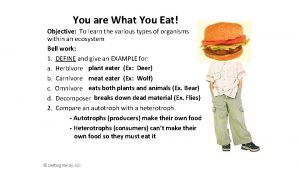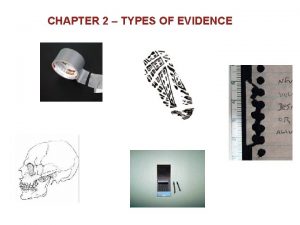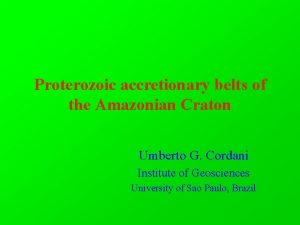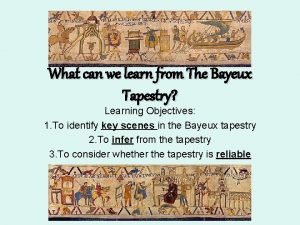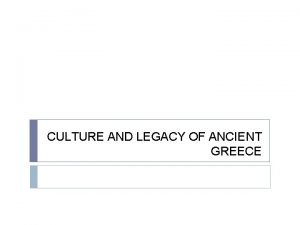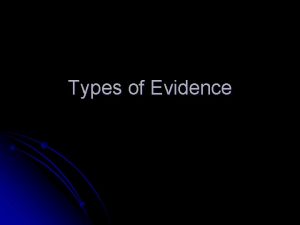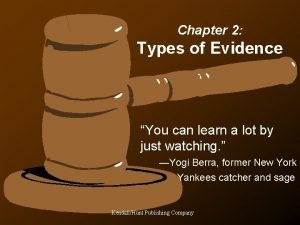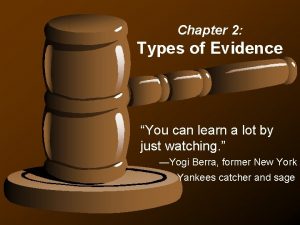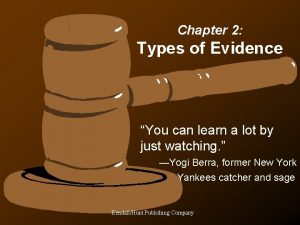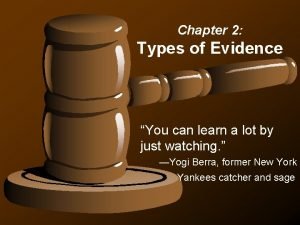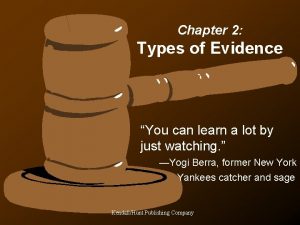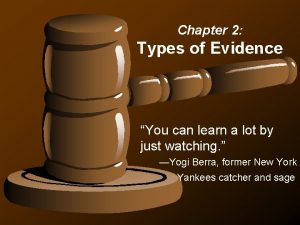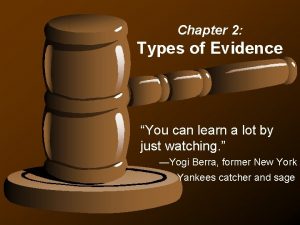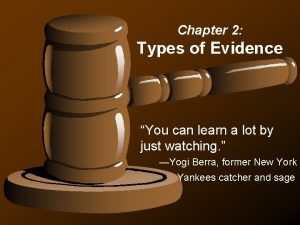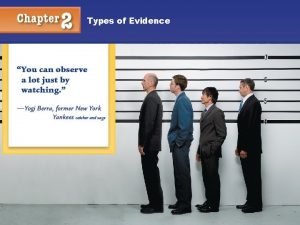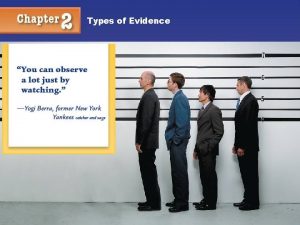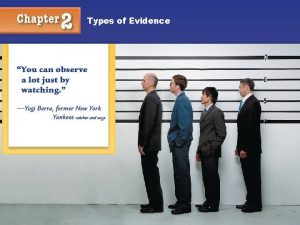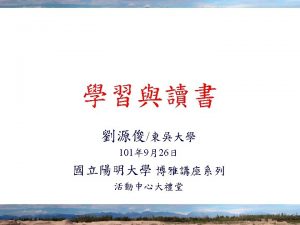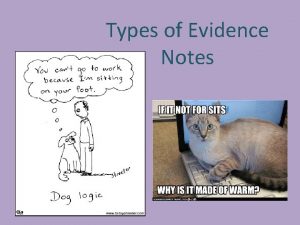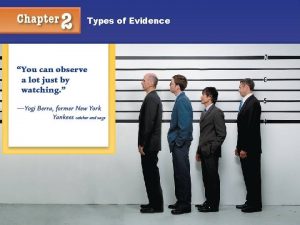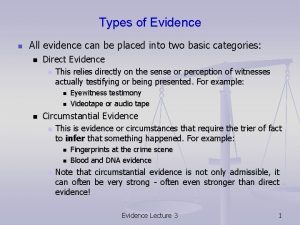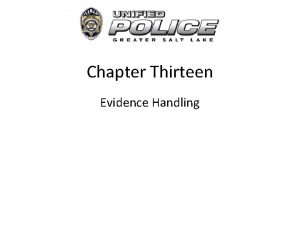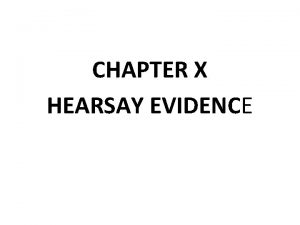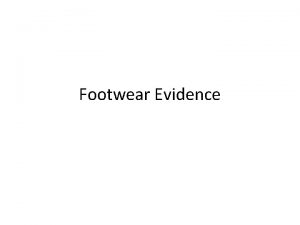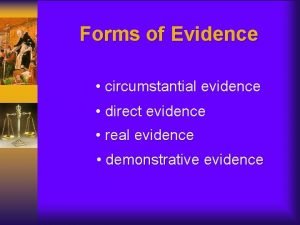Chapter 2 Types of Evidence You can learn


























- Slides: 26

Chapter 2: Types of Evidence “You can learn a lot by just watching. ” —Yogi Berra, former New York Yankees catcher and sage

Types of Evidence Two general types: § Testimonial—a statement made under oath; also known as direct evidence or Prima Facie evidence § Physical—any object or material that is relevant in a crime; also known as indirect evidence. Examples are hair, fiber, fingerprints, documents, blood, soil, drugs, tool marks, impressions, glass. Chapter 2 Kendall/Hunt Publishing Company 1

Reliability of Eyewitness Factors: § Nature of the offense and the situation in which the crime is observed § Characteristics of the witness § Manner in which the information is retrieved Additional factors: § Witness’s prior relationship with the accused § Length of time between the offense and the identification § Any prior identification or failure to identify the defendant § Any prior identification of a person other than the defendant by the eyewitness Chapter 2 Kendall/Hunt Publishing Company 2

Eyewitness § A police composite may be developed from the witness testimony by a computer program or forensic artist. § “Perception is reality. ” § As a result of the influences in eyewitness memory, physical evidence becomes critical. Chapter 2 Faces—a composite program by Inter. Quest Kendall/Hunt Publishing Company 3

Case Study: Coral Eugene Watts 4 Convicted in 1981 of burglary with intent to murder 4 Sentenced to 60 years in prison 4 Sentenced shortened to 25 4 Prosecutors reopened old cases 4 Eyewitness testimony 25 years later was submitted as evidence 4 In 2004 Watts found guilty of murder and sentenced to life Chapter 2 Kendall/Hunt Publishing Company 4

Value of Physical Evidence § Generally more reliable than testimonial § May not prove a fact and is therefore circumstantial evidence § Can prove that a crime has been committed § Can corroborate or refute testimony § Can link a suspect with a victim or with a crime scene § Can establish the identity of persons associated with a crime § Can allow reconstruction of events of a crime Chapter 2 Kendall/Hunt Publishing Company 5

Reconstruction Physical Evidence is used to answer questions about: § § what took place how the victim was killed number of people involved sequence of events A forensic scientist will compare the questioned or unknown sample with a sample of known origin. Chapter 2 Kendall/Hunt Publishing Company 6

Case Study: Ronald Cotton 4 Arrested for breaking into two apartments and attacked women living there 4 Photo identification was made by victim 4 Convicted and sentenced to life plus 54 years 4 Claimed innocence 4 DNA testing 11 years later was not a match to Cotton 4 Matched Bobby Poole, an inmate 4 Jennifer Thompson now an activist against death penalty Chapter 2 Kendall/Hunt Publishing Company 7

Types of Physical Evidence § Transient Evidence — temporary; easily changed or lost; usually observed by the first officer at the scene § Pattern Evidence — produced by direct contact between a person and an object or between two objects § Conditional Evidence — produced by a specific event or action; important in crime scene reconstruction and in determining the set of circumstances or sequence within a particular event § Transfer Evidence — produced by contact between person(s) or object(s), or between person(s) and person(s) § Associative Evidence — items that may associate a victim or suspect with a scene or each other; ie, personal belongings —Lee and Labriola in Famous Cases, 2001 Chapter 2 Kendall/Hunt Publishing Company 8

Examples of Transient Evidence § Odor—putrefaction, perfume, gasoline, urine, burning, explosives, cigarette or cigar smoke § Temperature—surroundings, car hood, coffee, water in a bathtub, cadaver § Imprints and indentations— footprints, teeth marks in perishable foods, tire marks on certain surfaces § Markings Chapter 2 Kendall/Hunt Publishing Company 9

Examples of Pattern Evidence—most are in the form of imprints, indentations, striations, markings, fractures or deposits. § § § Blood spatter Glass fracture Fire burn pattern Furniture position Projectile trajectory Tire marks or skid marks Chapter 2 § Clothing or article distribution § Gun powder residue § Material damage § Body position § Tool marks § Modus operandi Kendall/Hunt Publishing Company 10

Examples of Conditional Evidence § Light — headlight, lighting conditions § Smoke — color, direction of travel, density, odor § Fire — color and direction of the flames, speed of spread, temperature and condition of fire § Location — of injuries or wounds, of bloodstains, of the victim’s vehicle, of weapons or cartridge cases, of broken glass Chapter 2 § Vehicles — doors locked or unlocked, windows opened or closed, radio off or on (station), odometer mileage § Body — position, types of wounds; rigor, livor and algor mortis § Scene — condition of furniture, doors and windows, any disturbance or signs of a struggle Kendall/Hunt Publishing Company 11

Examples of transfer evidence 4 Hammer with human blood 4 Burdocks with hair 4 Hair with brush 4 Saliva with cup 4 Sock fuzz with toes Chapter 2 Kendall/Hunt Publishing Company 12

Examples of associative evidence 4 Driver’s license in car 4 Wedding band 4 Dog tags 4 Barrette 4 Eye glasses Chapter 2 Kendall/Hunt Publishing Company 13

Classification of Evidence by Nature § Biological — blood, semen, saliva, sweat, tears, hair, bone, tissues, urine, feces, animal material, insects, bacterial, fungal, botanical § Chemical — fibers, glass, soil, gunpowder, metal, mineral, narcotics, drugs, paper, ink, cosmetics, paint, plastic, lubricants, fertilizer § Physical — fingerprints, footprints, shoe prints, handwriting, firearms, tire marks, tool marks, typewriting § Miscellaneous — laundry marks, voice analysis, polygraph, photography, stress evaluation, psycholinguistic analysis, vehicle identification Chapter 2 Kendall/Hunt Publishing Company 14

Evidence Characteristics § Class — common to a group of objects or persons § Individual — can be identified with a particular person or a single source Fingerprints Chapter 2 Blood DNA Typing Kendall/Hunt Publishing Company 15

Class vs Individual Evidence Which examples do you think could be individual evidence? Chapter 2 Kendall/Hunt Publishing Company 16

Class vs Individual Evidence § These fibers are class evidence; there is no way to determine if they came from this garment. § The large piece of glass fits exactly to the bottle; it is individual evidence. Chapter 2 Kendall/Hunt Publishing Company 17

Can this evidence be individualized? 4 Activity p. 30 -32 4 Number your paper 1 to 15 4 Read the questions and answer appropriately 4 Read “Fracture Match” on p. 33 Chapter 2 Kendall/Hunt Publishing Company 18

How to increase probative value of class evidence 4 Find as many different types of objects as possible to link the suspect to the crime or the victim 4 Two pieces of evidence each alone belong to a large class of material; but both occurring together might greatly increase the probability of linking those to a certain individual 4 See activity on pg. 28 -29 Chapter 2 Kendall/Hunt Publishing Company 19

Forensic Investigations Include some or all of these seven major activities 1. Recognition —ability to distinguish important evidence from unrelated material § § Pattern recognition Physical property observation Information analysis Field testing 2. Preservation — collection and proper preservation of evidence Chapter 2 Kendall/Hunt Publishing Company 20

Investigations 3. Identification — use of scientific testing § § § Physical properties Chemical properties Morphological (structural) properties Biological properties Immunological properties 4. Comparison — class characteristics are measured against those of known standards or controls; if all measurements are equal, then the two samples may be considered to have come from the same source or origin. Chapter 2 Kendall/Hunt Publishing Company 21

Investigations 5. Individualization — demonstrating that the sample is unique, even among members of the same class 6. Interpretation — gives meaning to all the information 7. Reconstruction — reconstructs the events of the case § § Chapter 2 Inductive and deductive logic Statistical data Pattern analysis Results of laboratory analysis Kendall/Hunt Publishing Company 22 —Lee, Dr. Henry. Famous Crimes, 2001

Richard Crafts 4 One of the first cases where a person was convicted of murder without a body to prove that the crime had taken place Chapter 2 Kendall/Hunt Publishing Company 23

People in the News Dr. Henry Lee—Chief Emeritus for Scientific Services and the former Commissioner of Public Safety for the state of Connecticut. He served as that state’s Chief Criminality from 1979 to 2000. Lee was the driving force in establishing the modern forensic lab in Connecticut. He has worked with many high profile cases including O. J. Simpson, Jon Benet Ramsey, and the “wood chipper” case. He is also seen on many of the true crime shows, including his own, “Trace Evidence: The Case Files of Dr. Henry Lee”. Learn more at his website: www. drhenrylee. com/review. shtml Chapter 2 Kendall/Hunt Publishing Company 24

FBI Investigation Read a case investigated by the FBI. Observe the various units of their lab and read the section: “How They Do That? ”. www. fbi. gov/kids/6 th 12 th/investigates. htm Chapter 2 Kendall/Hunt Publishing Company 25
 If you think you can you can poem
If you think you can you can poem Fiber evidence can have probative value
Fiber evidence can have probative value Kinesthetic learner
Kinesthetic learner Learn from the ants
Learn from the ants If you can imagine it you can achieve it
If you can imagine it you can achieve it If you can't measure it you cant manage it quote
If you can't measure it you cant manage it quote If you can’t measure it, you can’t manage it
If you can’t measure it, you can’t manage it If you cannot measure it you cannot manage it
If you cannot measure it you cannot manage it Vertikale bilanzkennzahlen
Vertikale bilanzkennzahlen The more you study the more you learn
The more you study the more you learn Man lernt solange man lebt
Man lernt solange man lebt You are what you learn
You are what you learn Secondary sources
Secondary sources Primary evidence vs secondary evidence
Primary evidence vs secondary evidence Secondary sources
Secondary sources Primary evidence vs secondary evidence
Primary evidence vs secondary evidence Primary evidence vs secondary evidence
Primary evidence vs secondary evidence Class vs individual evidence
Class vs individual evidence Difference between testimonial and physical evidence
Difference between testimonial and physical evidence A pair of latex gloves was found at a crime scene
A pair of latex gloves was found at a crime scene Ecological fallacy definition
Ecological fallacy definition Chapter 2 types of evidence answers
Chapter 2 types of evidence answers What can we learn from the woopmay orogeny?
What can we learn from the woopmay orogeny? What can we learn from the passage
What can we learn from the passage Make your own bayeux tapestry
Make your own bayeux tapestry What can we learn from studying ancient greek artwork
What can we learn from studying ancient greek artwork Virtual reality slogans
Virtual reality slogans











